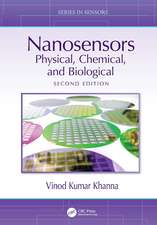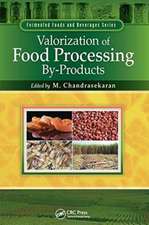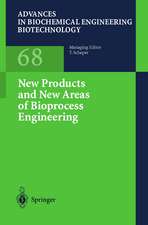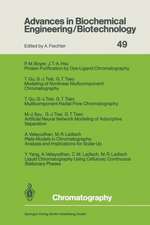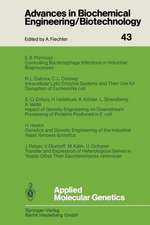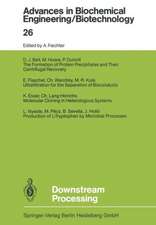Synthetic Biology of Yeasts: Tools and Applications
Editat de Farshad Darvishi Harzevilien Limba Engleză Hardback – 22 ian 2022
Split into two parts, the book opens with an introduction to rational metabolic pathway prediction and design using computational tools and their applications for yeast systems and synthetic biology. Then, it focuses on the construction and assembly of standardized biobricks for synthetic pathway engineering in yeasts, yeast cell engineering and whole cell yeast-based biosensors. The second part covers applications of synthetic biology to produce diverse and attractive products by some well-known yeasts.
Given its interdisciplinary scope, the book offers a valuable asset for students, researchers and engineers working in biotechnology, applied microbiology, metabolic engineering and synthetic biology.
| Toate formatele și edițiile | Preț | Express |
|---|---|---|
| Paperback (1) | 1111.97 lei 6-8 săpt. | |
| Springer International Publishing – 23 ian 2023 | 1111.97 lei 6-8 săpt. | |
| Hardback (1) | 1118.13 lei 6-8 săpt. | |
| Springer International Publishing – 22 ian 2022 | 1118.13 lei 6-8 săpt. |
Preț: 1118.13 lei
Preț vechi: 1363.58 lei
-18% Nou
Puncte Express: 1677
Preț estimativ în valută:
213.95€ • 223.98$ • 177.03£
213.95€ • 223.98$ • 177.03£
Carte tipărită la comandă
Livrare economică 07-21 aprilie
Preluare comenzi: 021 569.72.76
Specificații
ISBN-13: 9783030896799
ISBN-10: 303089679X
Pagini: 375
Ilustrații: VIII, 375 p. 52 illus., 42 illus. in color.
Dimensiuni: 155 x 235 mm
Greutate: 0.71 kg
Ediția:1st ed. 2022
Editura: Springer International Publishing
Colecția Springer
Locul publicării:Cham, Switzerland
ISBN-10: 303089679X
Pagini: 375
Ilustrații: VIII, 375 p. 52 illus., 42 illus. in color.
Dimensiuni: 155 x 235 mm
Greutate: 0.71 kg
Ediția:1st ed. 2022
Editura: Springer International Publishing
Colecția Springer
Locul publicării:Cham, Switzerland
Cuprins
Computational Prediction Tools for Synthetic Biology Components.- Computational Tools for Pathway Prediction and Design.- Computational Tools for Metabolic Modeling.- Computational Tools for Strain Optimization.- New Tools for the Synthesis of Standardized Biobricks.- Assembly of Standardized Biobricks and Construction of Pathways.- New and Powerful Genome Editing Methods.- Optimization of Synthetic Pathways.- Engineering of Yeast Consortia. Synthetic Biology of Yeasts for Pharmaceuticals Production.
Notă biografică
Farshad Darvishi Harzevili is a faculty member of Alzahra University and University of Maragheh, Iran and head of the microbial biotechnology and bioprocess engineering (MBBE) group. He is mainly interested in the biotechnological and environmental applications of yeasts to the production of biotechnologically valuable products. He is also interested in the expression of heterologous proteins, metabolic engineering, and synthetic biology of yeasts. Professor Darvishi's research group is active in the following areas: 1) New and powerful methods for strain characterization (X-Omics such as genomics, metagenomics, transcriptomics, proteomics, metabolomics, lipidomics, fluxomics) and improvement (such as metabolic engineering, reverse metabolic engineering, adaptive laboratory evolution (ALE), systems biology, synthetic biology). 2) Heterologous protein expression in Saccharomyces cerevisiae, Yarrowia lipolytica, Pichia pastoris and other nonconventional yeasts. 3) Production of biotechnologically valuable products from renewable sources and wastes. 4) Isolation and biodiversity study of yeasts.
Textul de pe ultima copertă
This book covers recent advances and future trends in yeast synthetic biology, providing readers with an overview of computational and engineering tools, and giving insight on important applications. Yeasts are one of the most attractive microbial cell factories for the production of a wide range of valuable products, including pharmaceuticals, nutraceuticals, cosmetics, agrochemicals and biofuels. Synthetic biology tools have been developed to improve the metabolic engineering of yeasts in a faster and more reliable manner. Today, these tools are used to make synthetic pathways and rewiring metabolism even more efficient, producing products at high titer, rate, and yield.
Split into two parts, the book opens with an introduction to rational metabolic pathway prediction and design using computational tools and their applications for yeast systems and synthetic biology. Then, it focuses on the construction and assembly of standardized biobricks for synthetic pathway engineering in yeasts, yeast cell engineering and whole cell yeast-based biosensors. The second part covers applications of synthetic biology to produce diverse and attractive products by some well-known yeasts.
Given its interdisciplinary scope, the book offers a valuable asset for students, researchers and engineers working in biotechnology, applied microbiology, metabolic engineering and synthetic biology.
Split into two parts, the book opens with an introduction to rational metabolic pathway prediction and design using computational tools and their applications for yeast systems and synthetic biology. Then, it focuses on the construction and assembly of standardized biobricks for synthetic pathway engineering in yeasts, yeast cell engineering and whole cell yeast-based biosensors. The second part covers applications of synthetic biology to produce diverse and attractive products by some well-known yeasts.
Given its interdisciplinary scope, the book offers a valuable asset for students, researchers and engineers working in biotechnology, applied microbiology, metabolic engineering and synthetic biology.
Caracteristici
Provides an overview of computational tools for metabolic pathway design of yeasts Reviews synthetic biology/gene-editing tools for metabolic engineering of yeasts Covers production of high-value products

